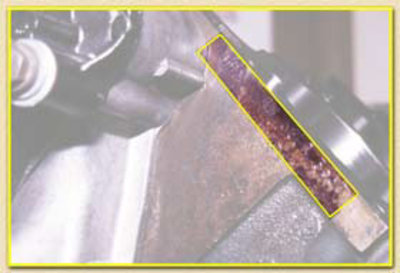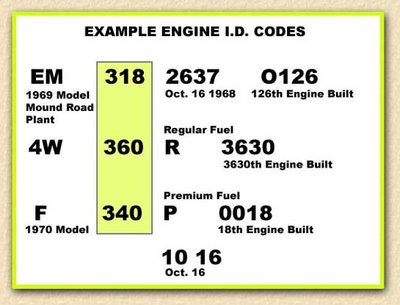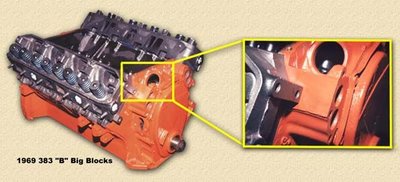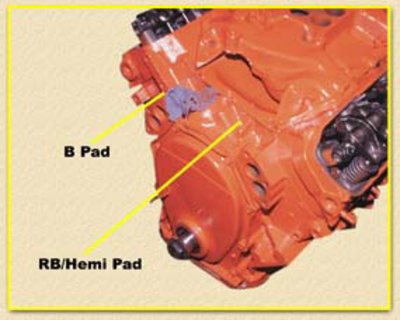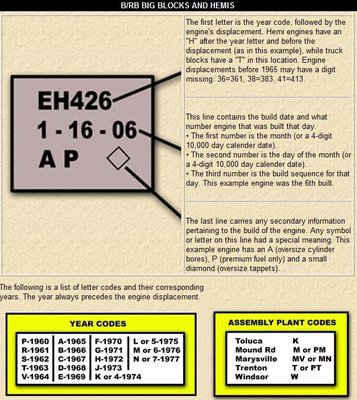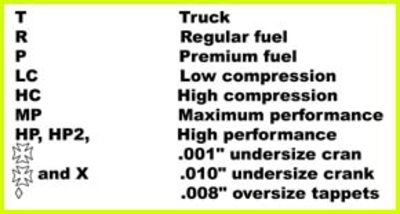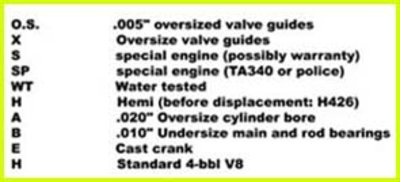The Year One website on this.
http://www.yearone.com/updatedsinglepag ... info1.html
I am going to post the main points here in case the Year One webpage stops working.
9 posts
• Page 1 of 1
De-coding Engine Numbers
Last edited by dave-r on 24 Jun 2009 10:19, edited 1 time in total.
-
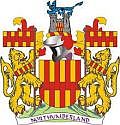
dave-r - Grumpy Old Man
- Posts: 9842
- Joined: 12 Oct 2003 21:45
- Location: North of the Tyne, England
273 "LA" Engine
1964-69 • 3.63" bore x 3.31" stroke
Realizing the need for a lighter V8 engine for use in the smaller vehicles then coming on the scene, Chrysler designed its first "thinwall" small block. Known as the "LA" engine series, the first engine out of the box was the 273. Light and compact, the 273 posed much less of an engineering challenge to fit in the new A-body chassis. While never intended to be a powerhouse, high compression, solid-cammed 4-bbl versions of the 273 did run well in cars like the Barracuda Formula S.
318 "A" Engine
1957-66 • 3.91" bore x 3.31" stroke
Filling the gap between the slant-6 and the early Hemi and later the "B" was the job of the 318 "A" engine. First produced in 1957, the first 318 employed "thickwall" casting techniques that, while very strong, handicapped it with excess weight. It did make decent power, was economical to operate and was reliable as a stone, making it perfect for its use as the base V8 engine.
318 "LA" Engine
1967-and-later • 3.91" bore x 3.31" stroke
Even though physically the 1967 318 "LA" V8 shared little more than bore and stroke dimensions with its "A" engine cousin, the two were identical with respect to their intended use. The "new" 318 was the base V8 powerplant for the entire Chrysler product line. Because of its lowly status, the 318 didn't even receive a 4-bbl carburetor and manifold until 1978, when the 360's setup was borrowed for use on the little workhorse. While the 318's pedigree may not match that of the Hemi, the fact that with a few modifications it's still in production some 30 years later speaks very highly of the engine's capabilities.
340 "LA" Engine
1968-73 • 4.04" bore x 3.31" stroke
The 340 should be considered the "Hemi of the small block family". Why? Simply because the 340 was designed from the outset as a performance engine. Look at the stats: high compression, big valves (2.02 intake, 1.60 exhaust), forged and shot-peened crank and rods, etc. These engines were built to perform well and stay together doing it. A testament to the 340's power potential is the fact that Chrysler installed the beefy A-727 Torqueflite automatic behind it instead of the usual 904, the only small block to receive such an honor. 340 development peaked with the 1970 6-bbl version available only in the limited-edition AAR 'Cuda and T/A Challenger (which were Dodge and Plymouth's entries into the SCCA's Trans-Am road racing series). Considerably underrated at 290 horsepower at 5000 rpm (not coincidentally, Chevy's Z/28 302 and Ford's Boss 302 were also rated at 290 horsepower), by turning it higher, which it was more than willing to do, resulted in much more power. The 6-bbl 340s had beefier blocks with thicker main webs to go along with the forged crank and rods. The cylinder heads were also unique to the 6-bbl engine. Chrysler relocated the intake pushrods, which allowed a much larger intake port opening and thus more flow. The valvetrain was adjustable, and induction chores were handled by three Holley 2-bbls on an aluminum intake manifold. In late 1972, with factory performance nearing an end, the 340 got a cast crankshaft and heads from the 360. But as far as small blocks go, the 340 is legendary.
360 "LA" Engine
1971-present • 4.00" bore x 3.58" stroke
Being the biggest of the small blocks doesn't necessarily mean that it was the best performer. Though only equipped with a 2-bbl and a relatively low compression, the 360 was still able to turn out 255 horsepower (gross rating) in its first year of production. The following two years weren't so kind to the 360 with horsepower levels falling to 175 and 170 respectively. Help did arrive in the form of a 4-bbl carb in 1974 though, and power rose to 245 net horsepower. Interestingly enough, the 360 is still in production, and the latest versions still generate 245 net horsepower. The beauty of the new engine is that through fuel injection and computer controls, this level of power is possible with good fuel mileage and low emissions.
1964-69 • 3.63" bore x 3.31" stroke
Realizing the need for a lighter V8 engine for use in the smaller vehicles then coming on the scene, Chrysler designed its first "thinwall" small block. Known as the "LA" engine series, the first engine out of the box was the 273. Light and compact, the 273 posed much less of an engineering challenge to fit in the new A-body chassis. While never intended to be a powerhouse, high compression, solid-cammed 4-bbl versions of the 273 did run well in cars like the Barracuda Formula S.
318 "A" Engine
1957-66 • 3.91" bore x 3.31" stroke
Filling the gap between the slant-6 and the early Hemi and later the "B" was the job of the 318 "A" engine. First produced in 1957, the first 318 employed "thickwall" casting techniques that, while very strong, handicapped it with excess weight. It did make decent power, was economical to operate and was reliable as a stone, making it perfect for its use as the base V8 engine.
318 "LA" Engine
1967-and-later • 3.91" bore x 3.31" stroke
Even though physically the 1967 318 "LA" V8 shared little more than bore and stroke dimensions with its "A" engine cousin, the two were identical with respect to their intended use. The "new" 318 was the base V8 powerplant for the entire Chrysler product line. Because of its lowly status, the 318 didn't even receive a 4-bbl carburetor and manifold until 1978, when the 360's setup was borrowed for use on the little workhorse. While the 318's pedigree may not match that of the Hemi, the fact that with a few modifications it's still in production some 30 years later speaks very highly of the engine's capabilities.
340 "LA" Engine
1968-73 • 4.04" bore x 3.31" stroke
The 340 should be considered the "Hemi of the small block family". Why? Simply because the 340 was designed from the outset as a performance engine. Look at the stats: high compression, big valves (2.02 intake, 1.60 exhaust), forged and shot-peened crank and rods, etc. These engines were built to perform well and stay together doing it. A testament to the 340's power potential is the fact that Chrysler installed the beefy A-727 Torqueflite automatic behind it instead of the usual 904, the only small block to receive such an honor. 340 development peaked with the 1970 6-bbl version available only in the limited-edition AAR 'Cuda and T/A Challenger (which were Dodge and Plymouth's entries into the SCCA's Trans-Am road racing series). Considerably underrated at 290 horsepower at 5000 rpm (not coincidentally, Chevy's Z/28 302 and Ford's Boss 302 were also rated at 290 horsepower), by turning it higher, which it was more than willing to do, resulted in much more power. The 6-bbl 340s had beefier blocks with thicker main webs to go along with the forged crank and rods. The cylinder heads were also unique to the 6-bbl engine. Chrysler relocated the intake pushrods, which allowed a much larger intake port opening and thus more flow. The valvetrain was adjustable, and induction chores were handled by three Holley 2-bbls on an aluminum intake manifold. In late 1972, with factory performance nearing an end, the 340 got a cast crankshaft and heads from the 360. But as far as small blocks go, the 340 is legendary.
360 "LA" Engine
1971-present • 4.00" bore x 3.58" stroke
Being the biggest of the small blocks doesn't necessarily mean that it was the best performer. Though only equipped with a 2-bbl and a relatively low compression, the 360 was still able to turn out 255 horsepower (gross rating) in its first year of production. The following two years weren't so kind to the 360 with horsepower levels falling to 175 and 170 respectively. Help did arrive in the form of a 4-bbl carb in 1974 though, and power rose to 245 net horsepower. Interestingly enough, the 360 is still in production, and the latest versions still generate 245 net horsepower. The beauty of the new engine is that through fuel injection and computer controls, this level of power is possible with good fuel mileage and low emissions.
Last edited by dave-r on 24 Jun 2009 10:10, edited 1 time in total.
-

dave-r - Grumpy Old Man
- Posts: 9842
- Joined: 12 Oct 2003 21:45
- Location: North of the Tyne, England
350 "B" Engine
1958 • 4.06" bore x 3.38" stroke
It may be hard to believe, but Chrysler built a 350 V8 some 9 years before the "Brand X" 350 arrived. The 1-year-only engine was considered a little brother to the 361. The Dodge Ram Fire version with single 4-bbl made 295 horsepower, while Plymouth's Golden Commando made 305 hp using two Carter 4-bbls.
361 "B" Engine
1958-66 • 4.12" bore x 3.38" stroke
Chrysler's new-for-'58 "B" engine faced the unenviable task of replacing the early Hemi as the company's biggest power producer. But, through solid engineering and modern (for the time) production techniques, the 361 proved up to the task. Although on the small end of the big-block scale, the 361 did pave the way for larger displacement engines in the years to come. Performance was good right out of the box, with a little-known electronically fuel-injected version making over 330 horsepower. While the later engines tend to grab most of the big-block glory, it all started with the 361.
383 "B" Engine
1959-71 • 4.25" bore x 3.38" stroke
For 1959, Chrysler engineers opened the bore of the 361 up to 4.25", a jump of almost 1/8", and the 383 was born. Destined to become the workhorse big block, the 383 struck a fine balance between power, reliability and (relative) economy of operation -- with an emphasis on power. A dual 4-bbl version released in 1963 was conservatively rated at 340 horsepower. By 1968, the single 4-bbl Super Commando 383 was rated (again conservatively) at 335 hp and was the standard engine in the new Road Runner, which became one of the most popular muscle cars ever built. Rarely the "star of the lineup", the 383 was nevertheless the standard bearer of Chrysler's big block family.
400 "B" Engine
1972-78 • 4.34" bore x 3.38" stroke
The largest of the short-stroke "B" engines, the 400 was a late arrival on the big-block scene. Designed with an eye on the unleaded gas/low emissions future, the 400 was created by enlarging 383's bore to 4.34". Compression ratios were kept low on the 400 since the engine was engineered to replace the base 383 in non-performance applications. That's not to say a 400 can't be built to perform, however. The big-bore/short-stroke combination is a sure recipe for horsepower, if blessed with some compression and a decent set of heads, since the engine can be revved without encountering the high piston speeds faced by long-stroke engines.
1958 • 4.06" bore x 3.38" stroke
It may be hard to believe, but Chrysler built a 350 V8 some 9 years before the "Brand X" 350 arrived. The 1-year-only engine was considered a little brother to the 361. The Dodge Ram Fire version with single 4-bbl made 295 horsepower, while Plymouth's Golden Commando made 305 hp using two Carter 4-bbls.
361 "B" Engine
1958-66 • 4.12" bore x 3.38" stroke
Chrysler's new-for-'58 "B" engine faced the unenviable task of replacing the early Hemi as the company's biggest power producer. But, through solid engineering and modern (for the time) production techniques, the 361 proved up to the task. Although on the small end of the big-block scale, the 361 did pave the way for larger displacement engines in the years to come. Performance was good right out of the box, with a little-known electronically fuel-injected version making over 330 horsepower. While the later engines tend to grab most of the big-block glory, it all started with the 361.
383 "B" Engine
1959-71 • 4.25" bore x 3.38" stroke
For 1959, Chrysler engineers opened the bore of the 361 up to 4.25", a jump of almost 1/8", and the 383 was born. Destined to become the workhorse big block, the 383 struck a fine balance between power, reliability and (relative) economy of operation -- with an emphasis on power. A dual 4-bbl version released in 1963 was conservatively rated at 340 horsepower. By 1968, the single 4-bbl Super Commando 383 was rated (again conservatively) at 335 hp and was the standard engine in the new Road Runner, which became one of the most popular muscle cars ever built. Rarely the "star of the lineup", the 383 was nevertheless the standard bearer of Chrysler's big block family.
400 "B" Engine
1972-78 • 4.34" bore x 3.38" stroke
The largest of the short-stroke "B" engines, the 400 was a late arrival on the big-block scene. Designed with an eye on the unleaded gas/low emissions future, the 400 was created by enlarging 383's bore to 4.34". Compression ratios were kept low on the 400 since the engine was engineered to replace the base 383 in non-performance applications. That's not to say a 400 can't be built to perform, however. The big-bore/short-stroke combination is a sure recipe for horsepower, if blessed with some compression and a decent set of heads, since the engine can be revved without encountering the high piston speeds faced by long-stroke engines.
Last edited by dave-r on 24 Jun 2009 10:11, edited 1 time in total.
-

dave-r - Grumpy Old Man
- Posts: 9842
- Joined: 12 Oct 2003 21:45
- Location: North of the Tyne, England
383 "RB" Engine
1959-60 • 4.03" bore x 3.75" stroke
This engine seems to be a greater point of confusion than any other engine. The 383 in this form is an "RB" engine (not the common 383 "B" engine). The 383 "RB" was only found in the Chrysler division car line from 1959-60 (in the Windsor and Saratoga models). Both a 2-bbl and 4-bbl existed with the 4-bbl making 325 hp. With only 2 years of production, these engines are quite rare today.
413 "RB" Engine
1959-65 • 4.18" bore x 3.75" stroke
By raising the deck height of the B engine (hence the RB, or "Raised B" designation), Chrysler was able to increase the stroke on their big blocks to 3.75", resulting in the 413 (when combined with a 4.18" bore). Initially only available in Chrysler division cars, Dodge and Plymouth got it in 1961. In 1962 the 413 Max Wedge was introduced and in the capable hands of racers like Dick Landy, the 413 was breaking records all over the country. Through fine-tuning and careful modification, Super Stock racers of the day were making upwards of 450 rear-wheel horsepower with the Max Wedge.
426 "RB" Engine
1963-65 • 4.25" bore x 3.75" stroke
By 1963, both Ford and GM had 420+ cubic-inch engines on the streets and race tracks of America. Obviously Chrysler had to keep up, and did so by opening the 413's bore to 4.25", thus creating the 426 Max Wedge. In its initial form, the 426 was only slightly more powerful (rated at 425 horsepower) than the 413 it replaced. But with the release of the Stage III 426 Max Wedge in 1964, all comparisons to the 413 ended. The '64 Max Wedge sported a lofty 13.0:1 compression ratio, a longer-duration cam, larger carbs and an elaborate equal-length "Tri-Y" exhaust manifold setup. The street 426 used a single 4-bbl, 10.5 compression ratio and a milder camshaft. While it obviously made less power than its Max Wedge brother, it was much more livable.
440 "RB" Engine
1966-78 • 4.32" bore x 3.75" stroke
If there's one golden rule of '60s engine design, it's simply bigger is better. Thus, the 440 cubic inch RB engine was born. Although debuting at a stout 365 horsepower in top form, the 440 was overshadowed by the Street Hemi which was released in the same year. But it didn't take long for the 440 to make a name for itself. In 1969-70, the 440 reached its highest state of tune with the fabled 6-bbl version rated at 390 hp. This number declined slightly in 1971 to 385 hp, which was the last year for the 3x2-bbl option. The 440 remained in production until 1978, although by then it had been strangled by the same unleaded fuel and emissions monster that ultimately killed all of Detroit's big blocks. But the fact remains that, at least on the street, the hot-rod 440 six bbl. engines of the '69-70 period would often humble a similar Hemi-equipped model.
1959-60 • 4.03" bore x 3.75" stroke
This engine seems to be a greater point of confusion than any other engine. The 383 in this form is an "RB" engine (not the common 383 "B" engine). The 383 "RB" was only found in the Chrysler division car line from 1959-60 (in the Windsor and Saratoga models). Both a 2-bbl and 4-bbl existed with the 4-bbl making 325 hp. With only 2 years of production, these engines are quite rare today.
413 "RB" Engine
1959-65 • 4.18" bore x 3.75" stroke
By raising the deck height of the B engine (hence the RB, or "Raised B" designation), Chrysler was able to increase the stroke on their big blocks to 3.75", resulting in the 413 (when combined with a 4.18" bore). Initially only available in Chrysler division cars, Dodge and Plymouth got it in 1961. In 1962 the 413 Max Wedge was introduced and in the capable hands of racers like Dick Landy, the 413 was breaking records all over the country. Through fine-tuning and careful modification, Super Stock racers of the day were making upwards of 450 rear-wheel horsepower with the Max Wedge.
426 "RB" Engine
1963-65 • 4.25" bore x 3.75" stroke
By 1963, both Ford and GM had 420+ cubic-inch engines on the streets and race tracks of America. Obviously Chrysler had to keep up, and did so by opening the 413's bore to 4.25", thus creating the 426 Max Wedge. In its initial form, the 426 was only slightly more powerful (rated at 425 horsepower) than the 413 it replaced. But with the release of the Stage III 426 Max Wedge in 1964, all comparisons to the 413 ended. The '64 Max Wedge sported a lofty 13.0:1 compression ratio, a longer-duration cam, larger carbs and an elaborate equal-length "Tri-Y" exhaust manifold setup. The street 426 used a single 4-bbl, 10.5 compression ratio and a milder camshaft. While it obviously made less power than its Max Wedge brother, it was much more livable.
440 "RB" Engine
1966-78 • 4.32" bore x 3.75" stroke
If there's one golden rule of '60s engine design, it's simply bigger is better. Thus, the 440 cubic inch RB engine was born. Although debuting at a stout 365 horsepower in top form, the 440 was overshadowed by the Street Hemi which was released in the same year. But it didn't take long for the 440 to make a name for itself. In 1969-70, the 440 reached its highest state of tune with the fabled 6-bbl version rated at 390 hp. This number declined slightly in 1971 to 385 hp, which was the last year for the 3x2-bbl option. The 440 remained in production until 1978, although by then it had been strangled by the same unleaded fuel and emissions monster that ultimately killed all of Detroit's big blocks. But the fact remains that, at least on the street, the hot-rod 440 six bbl. engines of the '69-70 period would often humble a similar Hemi-equipped model.
Last edited by dave-r on 24 Jun 2009 10:12, edited 1 time in total.
-

dave-r - Grumpy Old Man
- Posts: 9842
- Joined: 12 Oct 2003 21:45
- Location: North of the Tyne, England
426 Hemi
1964-65 Race only, 1966-71 Street version • 4.25" bore x 3.75" stroke
How do you spell the ultimate in production performance engines? H-E-M-I. The mighty 426 Hemi was conceived in the early '60s as the ultimate race engine, and ended up being the top powerplant of the muscle car era. But we're getting ahead of ourselves.
The story of the street Hemi actually starts in 1963, when Chevrolet set a new track record at Daytona with their Mark II "Mystery Motor", the forerunner to the Mark IV big block. The Chevrolets broke during the race, which led to a Ford sweep in the biggest race of the year. Now, at Chrysler, the handwriting was on the wall. Get competitive or get out. So the Race Hemi was created by taking the early Hemi heads and adapting them for use on the RB bottom end.
The mighty 426 race Hemi was ready for the '64 race, where Chrysler finished 1-2-3. The engine was a stunning success -- too much so in fact. Bill France, the Supreme Ruler of NASCAR, decreed that only production engines could be campaigned on his circuit. As a result, Chrysler boycotted the '65 season but they would return.
In 1966, the Street Hemi was born. With the engine now in production, the Hemi could be raced in NASCAR legally. The street version of the Hemi is surprisingly similar to the race-only version, with only minor changes made for civility. The compression ratio was lowered to a more livable 10.25:1. The radical cross ram manifold and lumpy cam didn't make it either, but the street version did receive two 4-bbl carbs (mounted inline) and a solid-lifter cam big enough to churn out 425 horsepower (which was substantially underrated). The valvetrain was essentially the same as the race units, although the valve springs were replaced with much softer units to keep cam wear to a minimum. The factory developed a set of cast-iron exhaust manifolds to replace the racing headers, which reduced noise and increased durability.
In street form the 426 Hemi became known as the top-dog muscle car powerplant until it disappeared after the 1971 model year (which, by the way, was also the last year for the 440 6-bbl). The Hemi did undergo a few running changes through its production life, with the most noticeable being the camshaft and block change in 1970. The mechanical cam was replaced with a hydraulic type, and the block was revised and strengthened also, basically making it suitable for use in fuel (nitro) drag racing. The rest, as they say, is history.
1964-65 Race only, 1966-71 Street version • 4.25" bore x 3.75" stroke
How do you spell the ultimate in production performance engines? H-E-M-I. The mighty 426 Hemi was conceived in the early '60s as the ultimate race engine, and ended up being the top powerplant of the muscle car era. But we're getting ahead of ourselves.
The story of the street Hemi actually starts in 1963, when Chevrolet set a new track record at Daytona with their Mark II "Mystery Motor", the forerunner to the Mark IV big block. The Chevrolets broke during the race, which led to a Ford sweep in the biggest race of the year. Now, at Chrysler, the handwriting was on the wall. Get competitive or get out. So the Race Hemi was created by taking the early Hemi heads and adapting them for use on the RB bottom end.
The mighty 426 race Hemi was ready for the '64 race, where Chrysler finished 1-2-3. The engine was a stunning success -- too much so in fact. Bill France, the Supreme Ruler of NASCAR, decreed that only production engines could be campaigned on his circuit. As a result, Chrysler boycotted the '65 season but they would return.
In 1966, the Street Hemi was born. With the engine now in production, the Hemi could be raced in NASCAR legally. The street version of the Hemi is surprisingly similar to the race-only version, with only minor changes made for civility. The compression ratio was lowered to a more livable 10.25:1. The radical cross ram manifold and lumpy cam didn't make it either, but the street version did receive two 4-bbl carbs (mounted inline) and a solid-lifter cam big enough to churn out 425 horsepower (which was substantially underrated). The valvetrain was essentially the same as the race units, although the valve springs were replaced with much softer units to keep cam wear to a minimum. The factory developed a set of cast-iron exhaust manifolds to replace the racing headers, which reduced noise and increased durability.
In street form the 426 Hemi became known as the top-dog muscle car powerplant until it disappeared after the 1971 model year (which, by the way, was also the last year for the 440 6-bbl). The Hemi did undergo a few running changes through its production life, with the most noticeable being the camshaft and block change in 1970. The mechanical cam was replaced with a hydraulic type, and the block was revised and strengthened also, basically making it suitable for use in fuel (nitro) drag racing. The rest, as they say, is history.
Last edited by dave-r on 24 Jun 2009 10:12, edited 1 time in total.
-

dave-r - Grumpy Old Man
- Posts: 9842
- Joined: 12 Oct 2003 21:45
- Location: North of the Tyne, England
BLOCK CASTING NUMBERS AND SYMBOLS
Chrysler engines may be identified in several ways. Obviously, no one will mistake a slant-6 for a Hemi (at least we hope they won't), but identifying which slant-6 or V8 a particular engine may be takes a little more investigation. One way is to locate the large casting number on the side of the block. Each engine displacement had a unique, or set of unique, casting numbers on the block. A 318 will never share a block casting number with a 273 or 340, nor will a 383 share a block casting number with a 361 or 400. A casting date also appears on the driver or passenger side of the block. The dates are in easy-to-read formats such as: 3.15.69 or 3-15-69 (which means, of course, March 15, 1969). This casting date is the day the block was cast at the foundry. Also on the side of the block is a symbol that looks like a clock, and it is, sort of. This symbol may be on either side, not necessarily next to the casting date, and it tells you the hour of the shift it was actually cast. The pointer in the symbol points to the hour of the shift it was cast. So, what shift was it cast on? Along with the casting date and clock, there's a Day/Night shift indicator (a D and N with a pointer aimed at one of the letters) that denotes the shift it was cast on. In summary, block casting numbers and symbols will tell you what year and displacement the engine is, and also what day it was cast, down to the hour of the shift it was first poured into the mold!
CASTING #------C.I.D.------YEAR/GROUP
G/RG SLANT-6 BLOCKS
2202843-----------170----------------G
2205630-----------170----------------G
2264478-----------170----------------G
2463230-----------170----------1965 G
----------------------198----------------G
2202857-----------225----------------RG
2205528-----------225----------------RG
2463430-----------225----------1966 RG
2806830-----------225----------------RG
A/LA SMALL BLOCKS
2465330-----------273-------1964-66 LA
2536130-----------273-----------1965 LA
2466090-----------318-----------------LA
2536030-318------318-------1967-75 LA
2566080-----------318-----------------LA
2806030-----------318-------1967-74 LA
2780930-340------340-------1968-73 LA
3577130TA-340---340-------1970-71 LA (Trans Am)
3418496-360------360-------1971-74 LA
3870230-----------360-------1975-UP LA
2264230-----------318--------1960-66 A
2468230-----------318------------------A
2532630-318------318------------------A
B BIG BLOCKS
2120229-----------361-----------------B (Industrial)
2205712-----------361--------1958-66 B
2468130-----------383--------1959-71 B
3614230-----------400--------1971-72 B
3698630-----------400--------1973-78 B
4006530-400-12--400-------1976-78 B
RB BIG BLOCKS
1852029-----------413----------1962 RB (Max Wedge)
2120529-----------413------1959-65 RB
2205697-----------413------1959-65 RB (Pass.car)
2468030-----------413----------------RB
2406730-----------426------1963-65 RB (Wedge)
2468330-----------426------1964-71 RB (Hemi)
2658836-----------426----------------RB (Industrial)
2536430-----------440------1966-72 RB
3698830-440------440-----1973-78 RB
CASTING #------C.I.D.------YEAR/GROUP
G/RG SLANT-6 BLOCKS
2202843-----------170----------------G
2205630-----------170----------------G
2264478-----------170----------------G
2463230-----------170----------1965 G
----------------------198----------------G
2202857-----------225----------------RG
2205528-----------225----------------RG
2463430-----------225----------1966 RG
2806830-----------225----------------RG
A/LA SMALL BLOCKS
2465330-----------273-------1964-66 LA
2536130-----------273-----------1965 LA
2466090-----------318-----------------LA
2536030-318------318-------1967-75 LA
2566080-----------318-----------------LA
2806030-----------318-------1967-74 LA
2780930-340------340-------1968-73 LA
3577130TA-340---340-------1970-71 LA (Trans Am)
3418496-360------360-------1971-74 LA
3870230-----------360-------1975-UP LA
2264230-----------318--------1960-66 A
2468230-----------318------------------A
2532630-318------318------------------A
B BIG BLOCKS
2120229-----------361-----------------B (Industrial)
2205712-----------361--------1958-66 B
2468130-----------383--------1959-71 B
3614230-----------400--------1971-72 B
3698630-----------400--------1973-78 B
4006530-400-12--400-------1976-78 B
RB BIG BLOCKS
1852029-----------413----------1962 RB (Max Wedge)
2120529-----------413------1959-65 RB
2205697-----------413------1959-65 RB (Pass.car)
2468030-----------413----------------RB
2406730-----------426------1963-65 RB (Wedge)
2468330-----------426------1964-71 RB (Hemi)
2658836-----------426----------------RB (Industrial)
2536430-----------440------1966-72 RB
3698830-440------440-----1973-78 RB
-

dave-r - Grumpy Old Man
- Posts: 9842
- Joined: 12 Oct 2003 21:45
- Location: North of the Tyne, England
Engine Stampings
SMALL BLOCK I.D. STAMP
Locating the I.D. pad on a small block is the simple part -- decoding the information is where it gets tricky (more on that later). The pad is found on the driver's side front of the block below the cylinder head on both "A" and "LA" small blocks. With the engine in the car and all the accessories in place, it may be hard to see, but it's there.
Decoding the I.D. boss on small blocks is difficult simply because not all engine production facilities used the same format when stamping the information. The types of information found on the pad includes engine displacement, a year code, a plant code, a production date, special notes about the engine, and a production sequence number. Unfortunately, not all the assembly plants included every bit of this information on the pad, and those that did inevitably changed the order in which it was listed. Confused yet? Don't worry, by the end of this you will be...
One piece of information that always appears is the engine displacement. This can only be one of four possible numbers: 273 (or 27), 318, 340, 360. Once the engine displacement is found, we can then try to decode the information around it.
To the left of the engine displacement there may be one or two characters. This (or these) characters can denote the production year only (in which case it would be a single alpha or numeric character), the assembly plant only or both, with the year usually preceding the plant code (which would be one digit and one alpha character, or two alpha characters).
If the character to the left of the displacement is a single digit, it represents the last number of the model year. If the single character to the left of the displacement is a letter, then a little more detective work is required since the letter could be year code or an assembly plant code. To determine which it is, check the casting date on the side of the block to determine what year it was cast, and compare this date to the Year Codes chart. If the year code letter matches the letter to the left of the displacement, then it's a year code. If it doesn't match, it's an assembly plant code.
Say, for example, you have a block cast in 1968 according to the casting date. Looking up 1968 in the Year Code chart you find "D" as the code. But the letter to the left of the displacement on the I.D. pad is an "M". This tells you it's not a year code, so it must be an assembly plant code, and "M" decodes as the Mound Road assembly plant. An example of two characters would be "4W", which decodes as a 1974 assembly date built at the Windsor, Ontario plant. As a side note, Chrysler never used the letter "I" when coding years, if a character that resembles this is before the engine displacement it would be a "one" making it a 1971 engine. See the list below for the assembly plants and their codes, these are the typical listings, but because of production inconsistencies some other codes may have been used.
Okay, if you thought the left side of the displacement number was tough, you ain't seen nothin' yet. To the right of the displacement number, there may be a letter or a symbol. This is "secondary" or "additional" assembly information. For example, if you see an "R" to the immediate right of the displacement number, as in "318R" it means this engine runs on regular fuel. If no letter is present to the immediate right, it means the assembly plant either failed to stamp it, no special notes need to be taken into consideration, or this information is placed elsewhere on the engine. For example, undersize crank information may be stamped on the #8 crank counterweight, or an oversize lifter bore may be stamped on the tappet boss. Like we said at the beginning of this section, there is very little in the way of formal guidelines on small blocks. See the chart under the big-block I.D. boss explanation for a guide to symbols, letters and their meaning.
Further to the right there may be one or two more sets of numbers. These could be the build-date of the engine, or the build-sequence number (which is simply what number this particular engine is in a "build cycle" for a particular plant), or both. The build-date can appear in two fashions, as a "10,000 day" date (ex: 2637) or as a standard month/day sequence (ex: 10 16 or 10-16). A "10,000-day calender" is comprised of, you guessed it, that many days, giving each day a unique number (which is in about a 28-year span). As a point of reference, January 1st, 1967 was the 1,983rd day on Chrysler's 10,000-day calender. With a calculator and a calender you should be able to convert your code to a standard date. Don't forget leap years ('64, '68, '72).
If you do find two sets of numbers, keep in mind that, usually, the build-date will appear before the build-sequence -- unless a second line of stampings is used (which isn't uncommon). If there is a second line, the date is almost always on it, which would make the number on the upper line the build sequence number. (All this makes that stuff to the left of the displacement number seem simple, right?) But if only one number is present, and there is no second line, then the number could be either, and you have to put your detective hat on again. Compare the casting dates to the numbers you've found to determine what the number is you're looking at.
Probably all we've done to this point is thoroughly confuse you. If so, don't feel bad, we're not sure about any of this either! We do recommend Galen Govier's book (part # GGB1), which lists all the assembly plants, codes, symbols, hieroglyphics, etc. Good luck and good hunting.
Locating the I.D. pad on a small block is the simple part -- decoding the information is where it gets tricky (more on that later). The pad is found on the driver's side front of the block below the cylinder head on both "A" and "LA" small blocks. With the engine in the car and all the accessories in place, it may be hard to see, but it's there.
Decoding the I.D. boss on small blocks is difficult simply because not all engine production facilities used the same format when stamping the information. The types of information found on the pad includes engine displacement, a year code, a plant code, a production date, special notes about the engine, and a production sequence number. Unfortunately, not all the assembly plants included every bit of this information on the pad, and those that did inevitably changed the order in which it was listed. Confused yet? Don't worry, by the end of this you will be...
One piece of information that always appears is the engine displacement. This can only be one of four possible numbers: 273 (or 27), 318, 340, 360. Once the engine displacement is found, we can then try to decode the information around it.
To the left of the engine displacement there may be one or two characters. This (or these) characters can denote the production year only (in which case it would be a single alpha or numeric character), the assembly plant only or both, with the year usually preceding the plant code (which would be one digit and one alpha character, or two alpha characters).
If the character to the left of the displacement is a single digit, it represents the last number of the model year. If the single character to the left of the displacement is a letter, then a little more detective work is required since the letter could be year code or an assembly plant code. To determine which it is, check the casting date on the side of the block to determine what year it was cast, and compare this date to the Year Codes chart. If the year code letter matches the letter to the left of the displacement, then it's a year code. If it doesn't match, it's an assembly plant code.
Say, for example, you have a block cast in 1968 according to the casting date. Looking up 1968 in the Year Code chart you find "D" as the code. But the letter to the left of the displacement on the I.D. pad is an "M". This tells you it's not a year code, so it must be an assembly plant code, and "M" decodes as the Mound Road assembly plant. An example of two characters would be "4W", which decodes as a 1974 assembly date built at the Windsor, Ontario plant. As a side note, Chrysler never used the letter "I" when coding years, if a character that resembles this is before the engine displacement it would be a "one" making it a 1971 engine. See the list below for the assembly plants and their codes, these are the typical listings, but because of production inconsistencies some other codes may have been used.
Okay, if you thought the left side of the displacement number was tough, you ain't seen nothin' yet. To the right of the displacement number, there may be a letter or a symbol. This is "secondary" or "additional" assembly information. For example, if you see an "R" to the immediate right of the displacement number, as in "318R" it means this engine runs on regular fuel. If no letter is present to the immediate right, it means the assembly plant either failed to stamp it, no special notes need to be taken into consideration, or this information is placed elsewhere on the engine. For example, undersize crank information may be stamped on the #8 crank counterweight, or an oversize lifter bore may be stamped on the tappet boss. Like we said at the beginning of this section, there is very little in the way of formal guidelines on small blocks. See the chart under the big-block I.D. boss explanation for a guide to symbols, letters and their meaning.
Further to the right there may be one or two more sets of numbers. These could be the build-date of the engine, or the build-sequence number (which is simply what number this particular engine is in a "build cycle" for a particular plant), or both. The build-date can appear in two fashions, as a "10,000 day" date (ex: 2637) or as a standard month/day sequence (ex: 10 16 or 10-16). A "10,000-day calender" is comprised of, you guessed it, that many days, giving each day a unique number (which is in about a 28-year span). As a point of reference, January 1st, 1967 was the 1,983rd day on Chrysler's 10,000-day calender. With a calculator and a calender you should be able to convert your code to a standard date. Don't forget leap years ('64, '68, '72).
If you do find two sets of numbers, keep in mind that, usually, the build-date will appear before the build-sequence -- unless a second line of stampings is used (which isn't uncommon). If there is a second line, the date is almost always on it, which would make the number on the upper line the build sequence number. (All this makes that stuff to the left of the displacement number seem simple, right?) But if only one number is present, and there is no second line, then the number could be either, and you have to put your detective hat on again. Compare the casting dates to the numbers you've found to determine what the number is you're looking at.
Probably all we've done to this point is thoroughly confuse you. If so, don't feel bad, we're not sure about any of this either! We do recommend Galen Govier's book (part # GGB1), which lists all the assembly plants, codes, symbols, hieroglyphics, etc. Good luck and good hunting.
Last edited by dave-r on 24 Jun 2009 10:59, edited 1 time in total.
-

dave-r - Grumpy Old Man
- Posts: 9842
- Joined: 12 Oct 2003 21:45
- Location: North of the Tyne, England
B and RB I.D. STAMP
BIG BLOCK: Locating the I.D. pad on big blocks is the easiest way to distinguish a "B" engine from an "RB" engine. On "B" engines the I.D. pad is located on the passenger's side of the engine just below the cylinder head next to the distributor base; on "RB" or Hemi engines the I.D. pad is located on top of the block directly in front of the the intake manifold valley pan, next to the distributor base toward the driver's side.
BIG BLOCK: Locating the I.D. pad on big blocks is the easiest way to distinguish a "B" engine from an "RB" engine. On "B" engines the I.D. pad is located on the passenger's side of the engine just below the cylinder head next to the distributor base; on "RB" or Hemi engines the I.D. pad is located on top of the block directly in front of the the intake manifold valley pan, next to the distributor base toward the driver's side.
-

dave-r - Grumpy Old Man
- Posts: 9842
- Joined: 12 Oct 2003 21:45
- Location: North of the Tyne, England
Secondary Codes
Here is a listing of the "additional" or "secondary" information codes and their meanings. These are found on the I.D. boss or sequence number of your engine. In the case of small blocks some of these symbols might be found on the affected part (a small diamond on the tappet boss, anything crank related is on the #8 counterweight). While this list is as complete as we can make it, there may be other codes or symbols not listed here. I.D. boss decoding is an ongoing project and new information is occasionally found.
-

dave-r - Grumpy Old Man
- Posts: 9842
- Joined: 12 Oct 2003 21:45
- Location: North of the Tyne, England
9 posts
• Page 1 of 1
